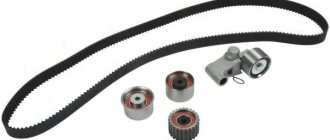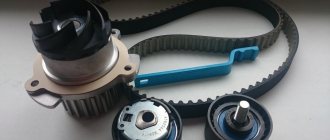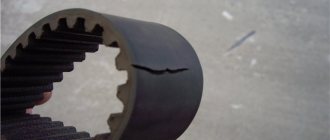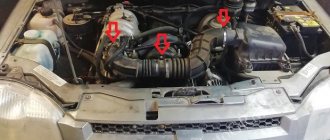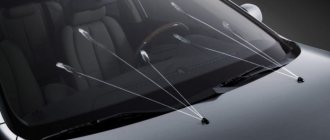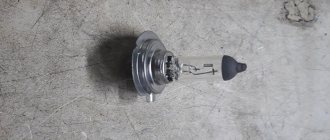One of the main functions in the French-made Renault Logan sedan is performed by the timing mechanism. The quality and reliability of the belt of this system determines how optimally the power unit of the car operates and creates the force to move the car. Quite often it is necessary to replace the timing belt, and you need to strictly follow all the rules, including remembering the timing marks.
Causes!
The timing belt can break for various reasons.
From all of the above, we understood that on all types of Renault Logan car engines, when the timing belt breaks, the valves bend. And below we will describe the reasons why breaks occur in general and how to avoid it.
- Timing belt wear (poor quality or technical wear), oil ingress, etc.
- Various foreign bodies getting under the belt
- Pump jams
- Tension roller(s) jam or loosen
- The crankshaft or camshaft is stuck
In order not to worry about the condition of the timing belt, you must constantly monitor its external condition, the degree of tension, replace it according to the regulations or change it immediately if there is any damage to it. Make sure that oil and other liquids do not come into contact with the belt (this will cause premature wear).
Consequences of a broken timing belt
This was once a piston and part of an engine
If, when the timing belt breaks, only the valves are bent, we can say that this is great luck. In some situations, such a breakdown may cause damage to the pistons themselves and the surfaces of the cylinders.
Symptoms and behavior of the car that require replacing the timing belt
As a result of increased loads or wear of the connecting rod and piston group, the timing belt may jump one turn, as a result of which the engine will begin to trip and operate unstably. This phenomenon is a symptom of checking the condition of the belt and its correct installation.
Frequency and signs of replacement
According to the regulations provided by the manufacturer, the timing belt of Renault Logan cars is changed after a mileage of 60 thousand km or after 4 years of operation. In addition, it is recommended to inspect transmission parts, as well as check and adjust the belt drive every 15,000 kilometers. And although the belt itself (provided it is original) easily runs for 90-120 thousand, it is not recommended to ignore factory requirements. The fact is that the pistons of the 8-valve engines K7J, K7M do not have enough recesses for the valve discs. If the belt breaks, the meeting of the valves with the pistons will be fatal: they will simply bend and the engine will fail. The belt may need to be replaced sooner than expected. Here are the factors that lead to its premature wear:
- ingress of engine oil;
- excessive tension force;
- a low-quality non-original distribution is used;
- the pump, tension roller or camshaft is blocked.
- cracks;
- material layering;
- cord separation;
- deforming changes in the form of folds, folds;
- wear or damage to individual teeth;
- lubricant
Chain or belt
There is a constant debate among car owners about which is better: a timing chain or a timing belt. There is simply no definite answer, since each type has its own advantages. According to many motorists, the chain is much stronger and has a longer service life. It is extremely unlikely that it will break during operation. However, with a timing chain, you won't have to worry about stretching.
On the other hand, of course, it has a number of disadvantages. Chains are more expensive than belts, they are much more difficult to put on, and they also make a lot of noise during operation. What is most important is that it is the belt drive that is installed. If you don’t want to experiment, we recommend using a classic belt from Renault, especially since the regulations for replacing the Renault Logan timing belt apply specifically to the strap, and for chains you will have to determine the service life yourself as you use them.
About the car
This car of this model is equipped depending on the country to which it will be delivered. This also applies to motors, the working volume of which can be from 1 thousand cm 3 to 1600 cm 3. Motors of the following modifications are intended for the regions of the Russian Federation:
- The 1.4 MPi engine has a displacement of 1400 cm3, 8 valves in the cylinder head.
- Engine 1.6 MPi with a displacement of 1600 cm3, 8 valves in the cylinder head.
- K4M engine with a working volume of 1600 cm3, 16 valves.
The main feature of this line of engines is the fact that the timing valve mechanism uses a toothed belt. The difference between belts for engines with 8 and 16 valves is their length and number of teeth. Power units can work together with both manual gearboxes and automatic transmissions. This car model is very popular among taxi drivers in the Russian Federation and CIS countries, as it is easy to maintain and has a decent service life before major repairs.
1.6 MPi engine on Renault Logan
Chain or belt
When considering the technical conditions of the car being developed, the designers considered the question of how to drive the timing valve mechanism. The chain was considered a more reliable drive element in this mechanism, but many motors in this drive already have a belt. Its use in the drive makes it possible to reduce the length of the power unit, which is mounted transversely in the engine compartment.
If you follow all recommendations for engine maintenance and use high-quality consumables, this will allow you to use the engine for a long period without significant problems. Therefore, in the debate about whether to use a belt or a chain in the drive in Renault Logan engines, the toothed belt won.
Replacement procedure: K7J and K7M motors 8 valves
Before you begin, carefully read the instructions and make sure that such work is up to you. If you set the Renault Logan timing marks incorrectly, the synchronization of the crankshaft and camshaft will be disrupted. What this threatens - we have already written earlier.
If there is no doubt, then adhere to the following procedure:
Raise the car on the right side with a jack and remove the front right wheel. A special metal shield will be installed on the right side of the motor to protect it from dirt. It needs to be dismantled. Next, you need to remove the generator drive belt, which prevents access to the timing belt installation site. Using a wrench or hand tool, unscrew the crankshaft pulley mounting bolt and remove the part from the unit. A wrench is preferable, since turning the wrench in a confined space will be inconvenient. It is necessary to install a stand under the engine of the machine so that when dismantling the right support nothing will collapse. If you do not want to dismantle the crankcase protection, you can find a special oblong block, the cross-section of which will be smaller than the hole in the protection for draining the engine oil. It is placed just under this hole. Next, you need to disconnect the tube that is used to bleed the adsorber
Carefully move it to the side and secure it with electrical tape or other means so that it does not interfere with the work. Next you will need a 16mm wrench. The right motor mount is attached to the timing unit and the housing with five bolts
It is necessary to unscrew them and remove the support assembly. Be sure to remove the dipstick so you don't accidentally damage it. It is recommended to seal the hole. To do this, you can use a plastic lid of suitable size or its equivalent. The protective panel must be removed through the lower opening of the engine compartment. It is secured to the mechanism with three bolts: one on top and two on the sides. Manufacturers use 10 or 8 bolts. It all depends on the year of manufacture of the car. Above the protective casing there is a metal cover. It also needs to be removed by unscrewing the five bolts on the sides. You will need several keys (10, 13 and 16). The next important step is to install the Logan timing mark. The mechanism must be positioned so that the mark on the camshaft pulley coincides with a similar one cast on the valve cover body. Attention! In all subsequent work, it is strictly forbidden to rotate the crankshaft or camshaft separately from each other, disrupting their synchronization. Dismantling begins with the tension roller, unscrewing it with a 16 key. As soon as the tension disappears, getting the belt out is not difficult. Clean all pulleys and rollers from dirt. Be careful not to accidentally turn the crankshaft or camshaft. Secure the tension roller into place by loosening it slightly. Tension the new belt. There are two marks on the product: lower and upper positions. They should match the similar symbols on the pulleys. Tension the belt and reassemble the structure in reverse order.
A pressing question is how to check the timing belt on a Renault Logan, in particular the tension? Here you need to try to turn the belt perpendicular to the axis on the longest section. It should rotate 90 degrees. If this indicator is higher or, conversely, the belt is almost impossible to give in, then the tension should be adjusted. You can also be guided by the two holes on the tension roller. When factory adjusted, they are parallel to the belt, which runs below the roller.
As you can see, the most important thing is to make sure that the phase is not disturbed and the crankshaft is installed in a synchronous position with the camshaft. Before assembly, always check that all marks are aligned correctly.
In the end, all that remains is to start the engine and make sure that the unit is working normally and there is no noise from the rollers or pulleys. As a rule, when replacing the timing belt, the rollers are also replaced; the latter often wear out, weakening the tension.
Replacing the timing belt of Renault Megane 1 K4M with your own hands
The reason for a quick belt break can be not only the expiration of the replacement period, but also the installation of low-quality, cheap counterfeit products, which, in principle, do not last long. We recommend installing only the original or brands approved by the manufacturer.
The original article number is 7701474359 or 130C13191R.
Prepare in advance:
- a set of various keys, hexagons and screwdrivers;
- crankshaft (mot-1489) and camshaft (mot-1469) clamp;
- unnecessary rags;
- VD-shka;
- a pair of jacks;
- timing kit;
- bypass and tension rollers.
Work order:
- The front right wheel must be jacked up, suspended and removed.
- Remove the pan and fender liner protection.
Remove the accessory drive belt by releasing the tensioner.
- Now you need to jack up and hang the engine slightly.
- Remove the fasteners from the engine mount (also known as the cover) near the gas distribution mechanism.
Remove 2 pcs. plastic camshaft plugs from the end of the cylinder head (from the gearbox side).
- Next, you need to find an opening in the clutch housing at the bottom of the engine to provide access to the flywheel crown.
- Insert a power screwdriver into the hole and jam the crankshaft, then remove the fastener holding the drive pulley of the accessory (at this moment, the help of a second person is necessary, since it is impossible to hold the shaft and remove the bolt alone).
- Rotate the crankshaft until the camshaft grooves near the gearbox (where the plugs were previously removed) line up horizontally in a straight line. The straight line must be located below the level of the shaft axis. The procedure is described in more detail below.
Changing the belt
The new timing belt is directional and has marks on it that should match the marks on the pulleys. If your tension pulley is in good condition and does not require replacement, it is still best to remove it. This will give us more space to change the belt. We remove the old timing belt and install a new one in its place. First of all, we install it on the camshafts so that it does not sag, and then we pull it onto the pump and the parasitic roller.
When replacing the belt, make sure that the pulleys do not rotate. A slight deviation of one tooth is unacceptable. When the timing belt is installed, check the alignment of the marks on the belt and the shaft gears (see Fig. 3) - if they match, you can assemble the timing belt.
rice. 3
Install the tension roller and use it to tighten the timing belt. It’s easy to find out how well the belt is tensioned - try moving it up or down with your finger. If the belt deviates by more than a finger width, the roller needs to be tightened. When the required tension force has been achieved, we assemble the gas distribution mechanism.
Reinstall the plugs on the camshafts. Make sure once again that the marks on all pulleys match the mating marks on the engine housing, then unscrew the bolt and close the hole with a plug. Assemble the timing case, jack up the engine and replace the right mount. We remove the engine from the jack and install the crankcase protection. We return the receiver to its place, put on the boot and put the wheel in place.
Video tutorial
A visual aid for replacing the timing belt is presented below. In the first video we will look at the specifics of Logan until 2010. And in the second after 2010.
What else you can read:
- Kia Sid station wagon 2017-2018 – For lovers of “barns”
- Ravon Matiz 2016-2017 – Leader of class “A”
- Skoda Kodiak 2022 – Czech Crossover Bear
- Toyota Camry 2022 – XV60 promises emotions
- Nissan Terrano 2016-2017 – Tyrant and despot on the road.
- Toyota Land Cruiser 300 – And this will happen...
- Land Rover Discovery Sport 2017-2018 – Extreme in comfortable conditions
- How to change the oil in a Nissan X-Trail variator?
Replacement on an 8-valve engine
Before further disassembling the mechanism, the crankshaft should be installed in the required position by rotating the camshaft gear mounting bolt. The mark on the gear must match the Latin letter D (Dachia logo) on the cylinder head housing. What the alignment of the Renault Logan marks looks like before replacing the timing belt can be seen in the photo:
Further actions are performed according to the algorithm:
- Loosen the tension roller bolt and release the timing belt tension.
- Remove the belt. It is more convenient to do this together with the crankshaft gear; it is pulled together by 2 bolts screwed into the technological holes.
- Remove the tension roller, clean and wipe all internal surfaces.
- Install a new roller on the axle and tighten the nut.
- Place the new belt on the Renault Logan crankshaft gear so that the white stripe on it coincides with the mark on the gear.
- Place the gear together with the belt in place and put it on the remaining pulleys, tensioning it by hand. In this case, its upper white stripe should be opposite the camshaft mark and letter D.
Attention! New parts must be installed in compliance with the direction of rotation of the mechanism, guided by the arrows drawn on the outside of the belt. Taking this opportunity, before installation and assembly, it is recommended to check the condition of all oil seals for oil leaks
You should also make sure that the pump bearing is working properly by checking its play. It may not be possible to replace worn parts, but you will be aware of impending failures and will be able to prepare
Taking this opportunity, before installation and assembly, it is recommended to check the condition of all oil seals for oil leaks. You should also make sure that the pump bearing is working properly by checking its play. It may not be possible to replace worn parts, but you will be aware of impending failures and will be able to prepare.
An important question is how to tighten the Renault Logan timing belt. First, you need to remove the slack from the pump side by slightly turning the camshaft gear with a wrench. Once tension is secured, take the pliers and insert them into the holes of the tension roller. Turn it counterclockwise approximately 80° and secure it with a nut. The belt tension is sufficient if in the free area it can be rotated around its own axis by no more than 90°.
It is important not to overtighten the timing belt, so as not to cause increased wear on the pump bearing. At the end of the operation, make 1-2 revolutions of the crankshaft and make sure that the tension has not weakened and nothing is preventing rotation
All that remains is to assemble the car and test it while driving. How to properly replace a Renault Logan belt is described in detail in video 1:
Consequences of not promptly replacing the timing belt on a car
A generator belt that, for some reason, has exhausted its service life may break. This will cause the pistons and valves of the car to meet as a result of a mismatch in the angles of rotation of the camshaft and crankshaft of the vehicle. Naturally, this unpleasant process will lead to failure of the entire power unit, the repair of which costs quite a significant amount of money. This situation is especially dangerous while driving, when the vehicle may lose control. The consequence of an accident can be injuries to other road users and damage to other people's property, which costs a considerable amount of money.
How to change consumables yourself
The timing belt replacement begins as follows: with the car jacked up, first remove the right wheel from the front axle. Behind the counter, you will have access to a black plastic protection, which is secured with a small nut. It is unscrewed manually and the casing is dismantled. The next step is to remove the drive belt and use wrench No. 15 to loosen the tension roller. This allows you to easily pull the belt off the pulley. There is a drain hole for the engine oil sump. It is located to the right towards the front edge of the crankcase on Renault Sandero models with 1.4 liter and 1.6 liter engines. The hole plug is supported by a stump (bar). Now the car is lowered slightly on the jack, which makes it possible to raise the power plant on an improvised support.
Afterwards the support will be removed. First, in the engine compartment, near the dipstick for checking the oil level, three bolts with 16mm hex heads are tightened. The upper frame of the timing mechanism is secured with 4 13mm bolts and one 10mm bolt. The casing can be easily removed when they are unscrewed.
The bottom bolts (2 pieces) are lubricated with sealant. It is necessary to lubricate thoroughly, as this affects the service life of the new set. Also, the sealant is a kind of valve protection.
The camshaft pulley on the Renault Sandero has recognizable channels that are located around the circumference. A block or rod is inserted into one of them to stop the rotation of the pulley. The number of bolts that need to be unscrewed is four. They are easily unscrewed with an 18mm wrench, without any effort.
Using a key, the shaft is rotated until the marks are aligned again - the white mark will be parallel to the “D” marker in the engine body. This will prevent damage to the valves. There is no such mark near the crankshaft pulley, so you need to arm yourself with a pencil and apply it. During installation, the gear returns to its original position.
To remove the timing belt from Renault Sandero, use key No. 13 to loosen the tension roller. The crankshaft gear is removed manually or using pliers that pull it out by the bolts. The bolts are screwed into the grooves on the gear in advance. Don't forget about the timing marks. Now you can install the new timing belt. The process is completely reverse to disassembly. It is necessary to ensure complete coincidence of the marks on the pulley and the area where the belt is marked, otherwise there is a possibility of damage to the valve mechanism, which is not uncommon on the 1.6 and 1.4 engines from Renault Sandero. So remember that timing marks must be observed.
What is needed to replace the belt?
New timing belt
For engines with a volume of 1.4 and 1.6 liters, the same set is always used: a belt and a tension roller. Therefore, manufacturers sell them as a set. The table shows the article number of the original timing belt for Renault Logan with 8 valves, article numbers of several popular analogues, as well as approximate prices for them.
| Manufacturer | vendor code | Approximate price, rub. |
| Renault (original) | 7701477024 | 2 100 |
| Contitech, Germany (analogue) | CT988K2 | 1 800 |
| Dayco, Italy (analog) | KTB259 | 1 510 |
| Amd, Korea (analog) | AMDKITBR63 | 1 340 |
Tools
To work you will need:
- heads and keys for 8, 10, 16, 18;
- extension;
- jack;
- engine support;
- ratchet with 10mm head;
- fork for tensioning the roller.
Belt brands, prices and articles, originals and analogues
The Renault Logan 1.4 liter eight-valve engine has the index K7J. The timing belt drive in this internal combustion engine is 96 teeth, the tension roller is one. To replace the belt on this unit, various kits are sold from such well-known brands as Bosch (art. no. 1 987 948 250), INA (art. 530 0490 10), and Contitech (art. CT988K2), etc.
The K4M timing belt has two camshafts and two rollers. Belt - 132 teeth. Various timing kits are also sold for this power unit. The choice is very huge. The most famous are kits from Renault (art. 130C17529R), Dayco (art. KTB460) and, of course, from Gates (art. K015671XS).
On average, a timing belt kit costs from 2 to 6 thousand rubles and the price tag largely depends on the brand. Both the belt and rollers are also sold separately, but buying them this way is not always profitable; it usually turns out to be even more expensive.
The range also includes budget spare parts, such as a tension pulley from Pilenga (for an 8-valve internal combustion engine), which costs only 400 rubles. If you compare it with the price tag for a roller from SKF (1300 rubles), you get a very noticeable difference.



